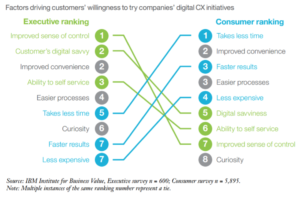Short-Term Success for LinkedIn & Snapchat; Apps Leading Mobile Browsers
by Hugh Williams on 13th Apr 2017 in News

ExchangeWire Research’s weekly roundup brings you up-to-date research findings from around the world, with additional insight provided by Rebecca Muir, head of research and analysis, ExchangeWire. In this week’s edition: Short-term success for LinkedIn and Snapchat; Apps leading mobile browsers; and Digital Disappointment.
Short-term success for LinkedIn and Snapchat
Consumers would rather brands use emerging technologies and features to communicate with them, finds research by Mailjet.
The findings show that email is the platform most people think we will definitely still be using in ten years’ time (41%), followed by Facebook, and private messaging apps like WhatsApp (26%). The widespread adoption of Facebook is clear; over-60s are now just as confident we’ll be using Facebook in 10 years’ time as young adults (25% of young adults versus 26% of over-60s).
In contrast, only 11% of people are certain that Pinterest and LinkedIn will be  used in a decade and only 14% are confident that Snapchat will still exist, despite the social platform’s parent company Snap IPO-ing earlier this year. This suggests that newer platforms can be perceived as passing trends rather than long-term means of communication.
used in a decade and only 14% are confident that Snapchat will still exist, despite the social platform’s parent company Snap IPO-ing earlier this year. This suggests that newer platforms can be perceived as passing trends rather than long-term means of communication.
When asked about major updates to technology commonly used for communication by brands, 35% of people responded saying they haven’t noticed a single one. For instance, only 6% noticed Instagram’s ‘buy button’ and only 8% saw the platform’s Explore page change. In addition, 15% find brand videos on Snapchat or Facebook intrusive and only 14% want to use live streams.
Apps leading mobile browsers
Consumers are spending more time within mobile apps and less time within mobile browsers, a US-study by eMarketer finds.
 However, the number of apps being used regularly is dropping, as users concentrate their activities on core apps. In 2017, the average US adult will spend 2hrs 25min per day using mobile apps, a jump of 10.3% over last year, and slightly higher than previously forecast.
However, the number of apps being used regularly is dropping, as users concentrate their activities on core apps. In 2017, the average US adult will spend 2hrs 25min per day using mobile apps, a jump of 10.3% over last year, and slightly higher than previously forecast.
This means time spent with mobile apps will reach 19.9% of average daily total media time this year.
Among mobile internet users, mobile apps will account for 84.9% of total mobile time spent, with mobile web browsing making up the remainder. Meanwhile, time spent with a mobile browser is expected to remain stagnant at 26min per day in 2017.
In 2016, US smartphone users used an average of 21 apps per month on their smartphones. By the end of the forecasting period, that number is expected to drop to 20.1 apps. App usage is mainly concentrated within social networks, Google, and utilitarian apps, such as maps and messaging apps.
Digital Disappointment
The majority of consumers are disappointed with digital brand experiences, suggests research by IBM. Seven-in-ten (70%) respondents are not impressed with the ‘experience revolution’.
The top reasons for disappointment are:
- CX didn’t work as expected
- The experience wasn’t convenient
- It was hard to use
- It was too confusing
The study also found that executives have underestimated the role age plays in the adoption of digital experiences. Only 38% of executives surveyed said age would have an impact on adoption. However, the survey found that 63% of the people who said they were excited about these technologies were millennials, 48% were generation X, and 39% were baby boomers.
Consumers and executives showed different drivers for willingness to try digital CX initiatives, which is detailed in the chart above. While consumers value the time saved by these initiatives, executives rate the improved sense of control as the main factor driving adoption.








Follow ExchangeWire